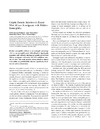Identificador persistente para citar o vincular este elemento:
https://accedacris.ulpgc.es/jspui/handle/10553/54456
| Campo DC | Valor | idioma |
|---|---|---|
| dc.contributor.author | Carranza Rodríguez, Cristina | en_US |
| dc.contributor.author | Pardo-Lledias, Javier | en_US |
| dc.contributor.author | Muro-Alvarez, Antonio | en_US |
| dc.contributor.author | Pérez-Arellano, José Luis | en_US |
| dc.date.accessioned | 2019-02-18T10:55:32Z | - |
| dc.date.available | 2019-02-18T10:55:32Z | - |
| dc.date.issued | 2008 | en_US |
| dc.identifier.issn | 1058-4838 | en_US |
| dc.identifier.other | WoS | - |
| dc.identifier.uri | https://accedacris.ulpgc.es/handle/10553/54456 | - |
| dc.description.abstract | Relative eosinophilia (defined as an eosinophil percentage >5% but an eosinophil count <450 cells/μL) is significantly associated with helminth infection in recently arrived West African immigrants (odds ratio, 20.5; 95% confidence interval, 2.7-154). The main parasitic causes related to relative eosinophilia are geohelminthic diseases (specifically, hook-worms) and schistosomiasis. | en_US |
| dc.language | eng | en_US |
| dc.relation.ispartof | Clinical Infectious Diseases | en_US |
| dc.source | Clinical Infectious Diseases [ISSN 1058-4838], v. 46 (6), p. E48-E50, (Marzo 2008) | en_US |
| dc.subject | 320505 Enfermedades infecciosas | en_US |
| dc.subject.other | Refugees | en_US |
| dc.subject.other | Diagnosis | en_US |
| dc.subject.other | Infections | en_US |
| dc.title | Cryptic parasite infection in recent west African immigrants with relative eosinophilia | en_US |
| dc.type | info:eu-repo/semantics/Article | en_US |
| dc.type | Article | en_US |
| dc.identifier.doi | 10.1086/528865 | en_US |
| dc.identifier.scopus | 40749094070 | - |
| dc.identifier.isi | 000253453800039 | - |
| dc.contributor.authorscopusid | 23975693400 | - |
| dc.contributor.authorscopusid | 23670753700 | - |
| dc.contributor.authorscopusid | 7006690116 | - |
| dc.contributor.authorscopusid | 7005553929 | - |
| dc.identifier.eissn | 1537-6591 | - |
| dc.description.lastpage | E50 | en_US |
| dc.identifier.issue | 6 | - |
| dc.description.firstpage | E48 | en_US |
| dc.relation.volume | 46 | en_US |
| dc.investigacion | Ciencias de la Salud | en_US |
| dc.type2 | Artículo | en_US |
| dc.contributor.daisngid | 344572 | - |
| dc.contributor.daisngid | 1701582 | - |
| dc.contributor.daisngid | 409562 | - |
| dc.contributor.daisngid | 445671 | - |
| dc.description.numberofpages | 3 | en_US |
| dc.utils.revision | Sí | en_US |
| dc.contributor.wosstandard | WOS:Carranza-Rodriguez, C | - |
| dc.contributor.wosstandard | WOS:Pardo-Lledias, J | - |
| dc.contributor.wosstandard | WOS:Muro-Alvarez, A | - |
| dc.contributor.wosstandard | WOS:Perez-Arellano, JL | - |
| dc.date.coverdate | Marzo 2008 | en_US |
| dc.identifier.ulpgc | Sí | en_US |
| dc.contributor.buulpgc | BU-MED | en_US |
| dc.description.jcr | 8,266 | - |
| dc.description.jcrq | Q1 | - |
| dc.description.scie | SCIE | - |
| item.grantfulltext | open | - |
| item.fulltext | Con texto completo | - |
| crisitem.author.dept | GIR IUIBS: Trypanosomosis, Resistencia a Antibióticos, Virología y Medicina Animal | - |
| crisitem.author.dept | IU de Investigaciones Biomédicas y Sanitarias | - |
| crisitem.author.dept | Departamento de Didácticas Específicas | - |
| crisitem.author.dept | GIR IUIBS: Trypanosomosis, Resistencia a Antibióticos, Virología y Medicina Animal | - |
| crisitem.author.dept | IU de Investigaciones Biomédicas y Sanitarias | - |
| crisitem.author.dept | Departamento de Ciencias Médicas y Quirúrgicas | - |
| crisitem.author.orcid | 0000-0002-2768-0072 | - |
| crisitem.author.orcid | 0000-0002-2936-8242 | - |
| crisitem.author.parentorg | IU de Investigaciones Biomédicas y Sanitarias | - |
| crisitem.author.parentorg | IU de Investigaciones Biomédicas y Sanitarias | - |
| crisitem.author.fullName | Carranza Rodríguez, Cristina | - |
| crisitem.author.fullName | Pérez Arellano, José Luis | - |
| Colección: | Artículos | |
Citas SCOPUSTM
27
actualizado el 08-jun-2025
Citas de WEB OF SCIENCETM
Citations
23
actualizado el 08-jun-2025
Visitas
105
actualizado el 24-feb-2024
Descargas
113
actualizado el 24-feb-2024
Google ScholarTM
Verifica
Altmetric
Comparte
Exporta metadatos
Los elementos en ULPGC accedaCRIS están protegidos por derechos de autor con todos los derechos reservados, a menos que se indique lo contrario.
